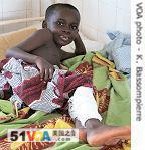2009-4-5
This is the VOA Special English Development Report.
Buruli ulcer is a bacterial disease that eats away muscle tissue. People can become disabled. They may even need to have an arm or leg removed. Buruli ulcer disease can be easily treated with antibiotics. Yet people often do not get medical help until the damage already has been done.
 |
| A child in Ivory Coast recovering from a Buruli ulcer infection |
Buruli ulcer is a disease found in tropical climates. It belongs to the same family of bacteria as those that cause tuberculosis and Hansen's disease, also known as leprosy.
Cases have been reported in Africa, the Americas, Asia and the western Pacific. At least thirty nations have had cases of Buruli ulcer disease. But experts say this condition has not gotten as much attention as it should.
It was just discussed during an international health conference held in Benin. Benin, Ghana and Ivory Coast have thousands of current cases of Buruli ulcer disease. Health officials believe other countries in West Africa have unreported cases.
Scientists are not sure how Buruli ulcer disease spreads or even how it develops in nature. They suspect it may involve mosquitoes or other organisms that live in water.
A British doctor reported the first cases of what was probably Buruli ulcer in eighteen ninety-seven in Uganda. Sir Albert Cook of the Church Missionary Society described the condition in patients at his Mengo Hospital in Kampala.
In nineteen forty-eight, Peter MacCallum and other scientists in Australia reported six cases near Melbourne. They also identified the bacterium that causes Buruli ulcer. The first complete genetic map was published in two thousand seven. That genome may lead to better treatment and control of the disease.
Public health officials hope that a treatment can be developed that does not require injections. If people could take the medicine by mouth, they would not need to travel to health clinics.
In the nineteen sixties there were many cases in an area then called Buruli County in Uganda. That explains the name Buruli ulcer, the most commonly used name for the disease.
And that's the VOA Special English Development Report. It was written by Jerilyn Watson.